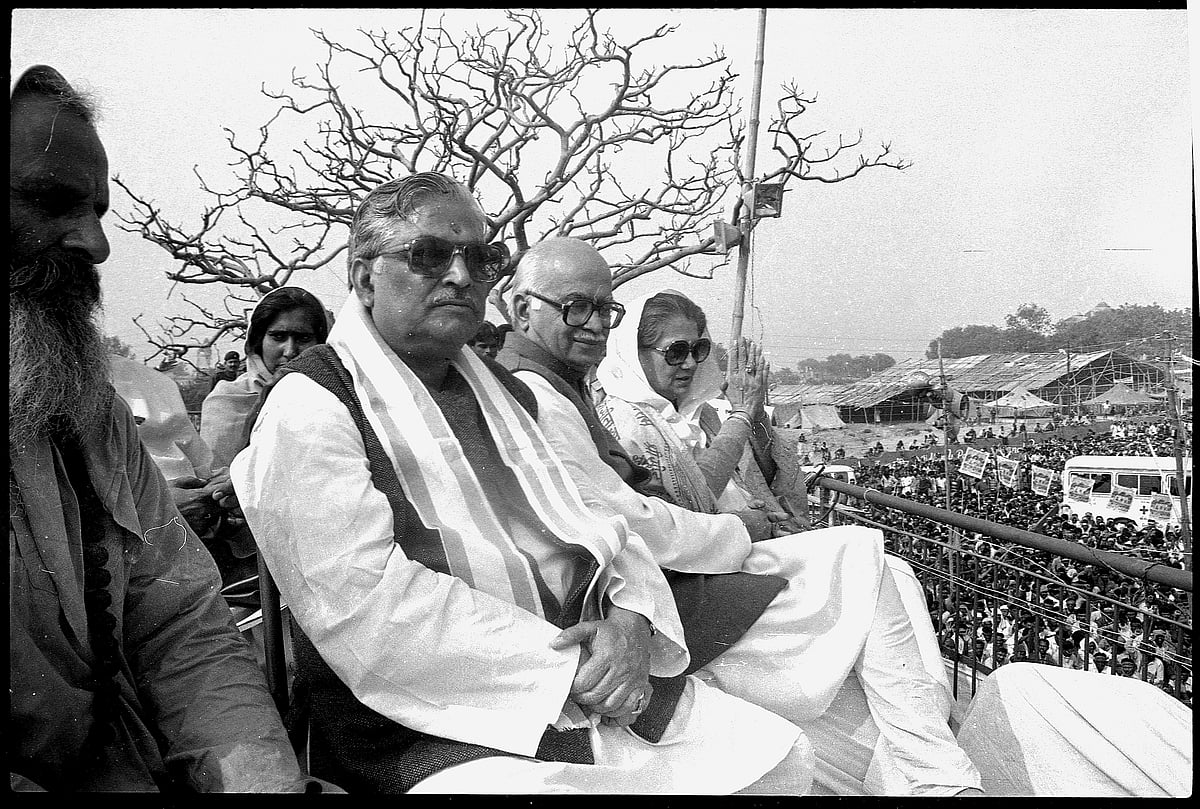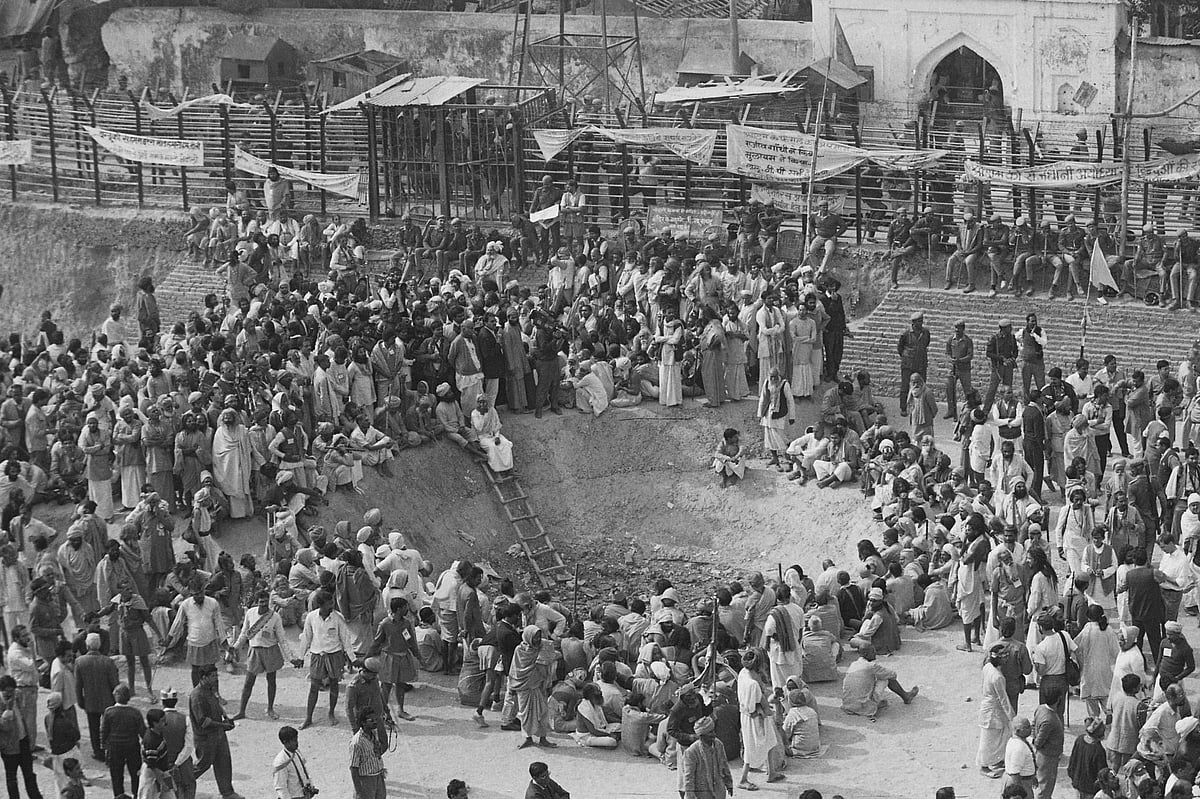People can lie, but images don’t...
Praveen Jain’s photo exhibition shows that photographs are more about the men behind the lens than the camera they use

It is the maniacal look in Kalyan Singh’s eyes that tells you the story. There is nothing but glee in him for having played whatever part he could in the demolition of Babri Masjid on December 6, 1992. Even the Supreme Court sending him to jail for contempt of court is of little consequence.
And just before you reach this photograph is another one, where you can see BJP leaders LK Advani and Murli Manohar Joshi monitoring the progress of the karsevaks in Ayodhya. And this photograph was taken days before the demolition. There can be no doubt about their involvement and it was not ‘spontaneous’, as has been often claimed.
It is capturing moments like these that make Praveen Jain the photojournalist that he is. He has seen it all, or maybe the most of what is referred to as history today. In an exhibition titled ‘200 & One’ at the All India Fine Arts & Crafts Society (AIFACS) gallery in the Capital, captured for posterity were images from the 1984 anti-Sikh riots to the Hashimpura massacre; the despair in the eyes of Rajiv Gandhi’s family after his assassination; the demolition of the Babri Masjid; the desolate image of NT Rama Rao’s widow Lakshmi Parvathy beside his funeral pyre and, of course, the rise of Narendra Modi as the
Prime Minister.
Jain, who is currently Associate Editor (Photo) at The Indian Express, began his career as a freelance photographer as a 21-year-old. He went on to learn the nuances of photojournalism by assisting S Paul, the then photo editor at The Indian Express. He has also worked with Surya India, India Week, Sunday Mail and The Pioneer.
Jain insists that there was nothing spontaneous about the Babri Masjid demolition. “I was there a day before and was a witness to the rehearsal drill. The karsevaks were practising using ropes to climb up a mound, just like they did at the dome the next day.
It was during his stint at Sunday Mail that he went to Meerut to cover a communal clash in 1987. He felt the tension in the air as soon as he entered the neighbourhood. Despite threats from the army, he has photos of Provincial Armed Constabulary (PAC) personnel of UP Police rounding up people and being taken away at gunpoint. Around 40 men were killed in cold blood. Jain’s photographs helped, in a large part, to bring justice to the families of these men, even though it took more than 30 years.
Looking at these photographs, there’s a chill that runs down your spine. You struggle to believe that this happened not so long ago.
But, it is the image of NT Rama Rao’s widow Lakshmi Parvathy crying beside his funeral pyre that leaves you slightly distraught within. It makes you realise the cruelty of politics; the coldness with which people are cast aside as soon as the person’s use is over. The current Andhra Pradesh Chief Minister Chandrababu Naidu had kicked her out right after NTR had died. His death had led to factionalism within the TDP and her faction was marginalised.
The sorrow and melancholy within Priyanka and Sonia Gandhi can be seen in Priyanka’s curled up toes and their downcast eyes. But, it’s not all doleful and woebegone. There are smiling pictures of Rajiv Gandhi who was, according to Jain, the most photogenic of all Prime Ministers. He says those were the days when Prime Ministers and politicians were not wary of journalists unlike now. “We were often invited to their homes; personal relationships were built. We knew how they lived and what kind of people they were. Today, photo-shoots are more prevalent,” said J
ain, pointing towards Lalu Prasad’s images.
The RJD president can be seen with his wife Rabri Devi and two sons, Tej Pratap and Tejashwi Yadav, living in the servants’ quarter of his brother
in Patna.
The warmth between a young Varun Gandhi and an older Priyanka Gandhi is evident in the pictures captured by Jain after the assassination of Rajiv Gandhi. Their grandmother might have had a problem with Maneka Gandhi, but the grandchildren tell another story. Ironically, it was also the time when Amitabh Bachchan used to be friends with their family.
You realise that just owning a camera does not make one a photographer, for the photographer is the instrument and not the camera. What stands out in all images is a personification of incidents and people. It makes you feel for those in these frozen frames. It reminds one of what American artist Andy Warhol once said, “The best thing about a picture is that it never changes, even when the people in it do.”
Follow us on: Facebook, Twitter, Google News, Instagram
Join our official telegram channel (@nationalherald) and stay updated with the latest headlines
- LK Advani
- Sonia Gandhi
- Babri Masjid
- Murli Manohar Joshi
- Priyanka Gandhi
- Kalyan Singh
- karsevaks
- Tej Pratap Yadav
- S Paul
- RJD leader Tejashwi Yadav
- Andhra Pradesh CM N Chandrababu Naidu
- Lalu Prasad
- Praveen Jain
- NT Rama Rao





